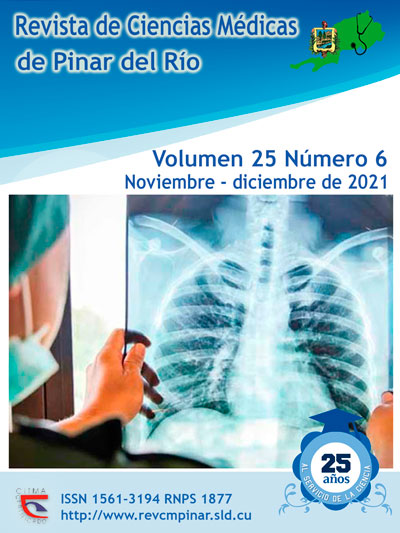Stiff-person syndrome: a case report
Keywords:
STIFF-PERSON SYNDROME, MUSCLE RIGIDITY, SPASM, PARANEOPLASTIC SYNDROMES.Abstract
Introduction: stiff-person syndrome (SPS) is a rare immune-mediated central nervous system disorder characterized by painful contraction, stiffness and spasms affecting the axial and peripheral musculature in a progressive manner.
Case report: a 47-year-old male patient, affected by stiffness and weakness in the right lower extremity, progressing in weeks to the other lower extremity and in months to the axial and proximal musculature of the four extremities; making ambulation, trunk flexion and arm movement difficult. He presented lumbar hyperlordosis and muscle spasms. Electromyography showed continuous muscle activity in agonist and antagonist muscles. Stiff person syndrome (SPS) was diagnosed. The treatment applied was immunomodulator (steroids and intravenous immunoglobulins) and symptomatic with benzodiazepines, baclofen and physical therapy, the evolution was satisfactory.
Conclusions: SPS is not frequent in neurological-clinical practice, its definitive diagnosis depends on specific complementary studies, and its clinical manifestations make it detectable allowing timely management and prevention of disabilities associated with these patients.
Downloads
References
1. El-Abassi R, Soliman MY, Villemarette-Pittman N, England JD. SPS: Understanding the complexity. Journal of the Neurological Sciences. [Internet]. 2019 [citado 01/07/2021]; 404 (2019): 137–149. Disponible en: https://www.researchgate.net/profile/Nicole-Villemarette-Pittman/publication/334527723_SPS_Understanding_the_complexity/links/5d935e90458515202b781a7a/SPS-Understanding-the-complexity.pdf
2. Moerch F, Woltman HW. Progressive and fluctuating muscular rigidity and spasm (stiffman syndrome): report of a case and some observations in 13 other cases. Proc Staff Meet Mayo Clin [Internet]. 1956 Jul [citado 01/07/2021]; 31(15): 421-7. Disponible en: https://pubmed.ncbi.nlm.nih.gov/13350379/
3. Muacevic A, Adler J, Ortiz J, Ghani M, Tambo W, Bashir F, et al. Stiff-Person Syndrome: A Treatment Update and New Directions. Cureus [Internet]. 2020 [citado 01/07/2021]; 12(12): 11995. Disponible en: https://www.ncbi.nlm.nih.gov/pmc/articles/PMC7793517/
4. Bernardo F, Rebordão L, Rêgo A, Machado S, Passos J, Costa C, et al. Stiff person spectrum disorders: An illustrative case series of their phenotypic and antibody diversity. Journal of Neuroimmunology [Internet]. 2020 [citado 01/07/2021]; 341: 577192. Disponible en: https://www.jni-journal.com/article/S0165-5728(19)30636-8/fulltext
5. Guajardo G, Cea G. Síndrome de persona rígida confundido por trastorno conversivo: un error común. Caso Clínico. Rev. méd. Chile [Internet]. 2019 [citado 01/07/2021]; 147(6): 799-802. Disponible en: http://www.scielo.cl/scielo.php?script=sci_arttext&pid=S003498872019000600799&lng=es
6. Caffrey D, Finn CT, Song SM, Burton III F, Arsan C. Stiff Person Syndrome and Psychiatric Comorbidities: A Systematic Review. Journal of the Academy of Consultation-Liaison Psychiatry [Internet]. 2021 [citado 01/07/2021]; 62(1): 3-13. Disponible en: https://www.sciencedirect.com/science/article/pii/S0033318220302395
7. Dade M, Berzero G, Izquierdo C, Giry M, Benazra M, Delattre J-Y, et al. Neurological syndromes associated with Anti-GAD antibodies. International Journal of Molecular Sciences. [Internet]. 2020 [citado 01/07/2021]; 21(10):3701. disponible en: https://www.ncbi.nlm.nih.gov/pmc/articles/PMC7279468/
8. Baizabal-Carvallo JF, Jankovic J. Autoimmune and paraneoplastic movement disorders: An update. Journal of the Neurological Sciences [Internet]. 2018 [citado 01/07/2021]; 385: 175-184. Disponible en: https://pubmed.ncbi.nlm.nih.gov/29406902/
9. Gómez-Fernández L, Maragoto-Rizo C, Jiménez-Gil FJ. Síndromes de actividad continua de las fibras musculares originados en el sistema nervioso. Rev Mex Neuroci [Internet]. 2013 [citado 01/07/2021]; 14(6): 349-355. Disponible en: http://previous.revmexneurociencia.com/wp-content/uploads/2013/11/Nm136-08.pdf
10. Balint B, Meinck HM. Pragmatic treatment of stiff person spectrum disorders. Movement Disorders Clinical Practice [Internet]. 2018 [citado 01/07/2021]; 5(4): 394-401. Disponible en: https://movementdisorders.onlinelibrary.wiley.com/doi/full/10.1002/mdc3.12629
11. Vaiyapuri A, Kashyap P, Kashyap N, Muthusamy H, Unnikrishnan R, Alqahtani M. Is stiff person syndrome benefited by physical therapy intervention? Summary of case reports. BioMed Research International [Internet]. 2019 [citado 01/07/2021]; 2019: 1-7. Disponible en: https://www.hindawi.com/journals/bmri/2019/5613680/
12. Sarva H, Deik A, Ullah A, Severt WL. Clinical spectrum of stiff person syndrome: a review of recent reports. Tremor and Other Hyperkinetic Movements [Internet]. 2016 [citado 01/07/2021]; 6: 340. Disponible en: https://www.ncbi.nlm.nih.gov/pmc/articles/PMC4790195/
13. Xie Y-y, Meng H-m, Zhang F-x, Maimaiti B, Jiang T, Yang Y. Involuntary movement in stiff-person syndrome with amphiphysin antibodies: A case report. Medicine [Internet]. 2021 [citado 01/07/2021]; 100(3): 24312. Disponible en: https://www.ncbi.nlm.nih.gov/pmc/articles/PMC7837982/
14. Hicken J, Ramirez D, Rigby M, Minasian A. Stiff-Person Syndrome: Seeing Past Comorbidities to Reach the Correct Diagnosis. Case Rep Neurol Med [Internet]. 2021 [citado 01/07/2021]; 2021: 6698046. Disponible en: https://www.ncbi.nlm.nih.gov/pmc/articles/PMC7868164/
Downloads
Published
How to Cite
Issue
Section
License
Authors who have publications with this journal agree to the following terms: Authors will retain their copyrights and grant the journal the right of first publication of their work, which will be publication of their work, which will be simultaneously subject to the Creative Commons Attribution License (CC-BY-NC 4.0) that allows third parties to share the work as long as its author and first publication in this journal are indicated.
Authors may adopt other non-exclusive license agreements for distribution of the published version of the work (e.g.: deposit it in an institutional telematic archive or publish it in a volume). Likewise, and according to the recommendations of the Medical Sciences Editorial (ECIMED), authors must declare in each article their contribution according to the CRediT taxonomy (contributor roles). This taxonomy includes 14 roles, which can be used to represent the tasks typically performed by contributors in scientific academic production. It should be consulted in monograph) whenever initial publication in this journal is indicated. Authors are allowed and encouraged to disseminate their work through the Internet (e.g., in institutional telematic archives or on their web page) before and during the submission process, which may produce interesting exchanges and increase citations of the published work. (See The effect of open access). https://casrai.org/credit/



